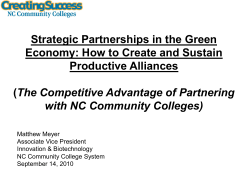
Full Text-PDF - Merit Research Journals
Merit Research Journal of Education and Review (ISSN: 2350 2350-2282) Vol. 3(4) pp. 170-173, April, 2015 Available online http://www.meritresearchjournals.org/er/index.htm Copyright © 2015 Merit Research Journals Original Research Article Differences between Students Gender and Self-concept S on their Academic Performance in Borno State College of Education: Implications for Counseling Umar Goni Goni* and Yagana Wali S. B Abstract Department of Education, University of Maiduguri *Corresponding Author’s E-mail: umargoni@yahoo.com Tel: 07063233277/08052619454 This is a survey study design to determine the differences between gender and self self-concept on students’ academic performance in colleges of education in Borno State. The study set o one research objective, one research question and tested one research hypothesis. hypothes Humanistic approach was applied to self self-concept. concept. The target population for this study was 4,517 students who have registered in NCE awarding institutions in Borno State. Purposive sampling technique was used to select two Colleges of Education in Borno Sta State, te, the stratified random sampling procedure was also employed to select (322) participant 186 students from 351NCE III students’ from Kashim Ibrahim College of Education, Maiduguri and 136 students from 210 NCE III students from Umar Ibn Ibrahim College off Education, Science and Technology, Bama. Students’ self-concept self scale (SSC) was used by the researchers. T-test was used to test the hypothesis hypothes raised in this study. The results indicated that there is no significant difference between student’s gende gender and self-concept concept of students on academic achievement. Based on the results obtained, the college counsellors should use their skills to advice students to double their effort. Keywords: Academic achievement, Differences, Implications for Counselling, Pattern attern of study INTRODUCTION Education is the process of developing the capacities and potentials of the individual so as to prepare that individual to be successful in a specific society or culture. From this perspective, education is serving primarily as an individual development function. nction. Education begins at birth and continues throughout life. It is constant and on on-going. Schooling generally begins somewhere between the ages four and six when children are gathered together for the purposes of specific guidance related to skills and competences that society deems important. In the past, once the formal primary and secondary schooling was completed the process was finished. However, in today’s information age, adults are quite often learning in informal setting throughout their working g lives and even into retirement. Education, in its broadest sense, may be defined as a process designed to inculcate the knowledge, skills and attitudes necessary to enable individuals to cope effectively with their environment. Its primary purpose is to foster and promote fullest individual self-realization realization for all people. Achieving these goals require understanding of commitment to the proposition that education is a primary instrument for social and economic advancement of human welfare (Verma, 1990). The world is becoming more and more competitive. Quality of performance has become the key factor for personal progress. Parents desire that their children climb the ladder of performance to as high a level as possible. This desire for high level of achievement achiev puts a lot of pressure on students, teachers and schools and in general the education system itself. In fact, it appears as if the whole system of education revolves round the academic achievement of students, though various other Goni and Wali 171 outcomes are also expected from the system. Thus a lot of time and effort of the schools are used for helping students to achieve better in their scholastic endeavors. The importance of scholastic and academic achievement has raised important questions for educational researchers (Nuthanap, 2007). As an individual grows and develops, he learns, not only about the world but about himself and his place in it. Each person lives with himself and hence, to some degree is always alone. No one can ever completely know the self-better than anyone else, although in the pursuit for understanding oneself and others there has developed much of human thought and philosophy, including psychology. Man has a long held in the hope of answering such question as: who am I? How did I come to be this way? And their logical consequence, the search for purpose; why am I? (Nadalmani, 2001). The psychological construct, self-concept is essentially private even though it is in part translated into action by beliefs we express. Sidhu (1987) defined self-concept as those perceptions, beliefs, feelings, attitudes, and values which the individual used in on describing him/herself. Personality is not a specific quality of a person’s but a quality of his/her behaviour. How he/she behave depend upon how he/she feels about him/herself, about other people and about his/her relationship with them. These feelings make up his/her self-concept what him /her thing about him/herself as a person. A person’s self-concept is the fundamental core of his entire personality and determines the quality of behaviour. It can be predicted that, poor self-concept, implying lack of confidence in facing and mastering the school environment, in fact, the self-concept does appear to be related to school adjustment. Substantial evidence indicates that children and adult with poor self-concept when compared with those who have high self-concept are more anxious and less adjusted generally and less popular. The pattern of parental rewards and punishments seems to affect the self-concept and quite certainly, the self-concept of bright but under achieving young stars are less positive than those of children who are doing well as can be expected in school. Incidentally children tend to mould their self-concept according to the way they think their teachers regarded them. Tymms and libbon (1992) examines the relationship between time spent on homework and exam grades among approximately 3000 students from school and colleges in Northeast England. Average time spent was 5 hrs. per week. Girls reported spending approximately 30 minutes/week more than boys. The study revealed that students who marked for long hours gained slightly better than those who worked for modest periods. Suneetha and Mayuri (2001) conducted a study on age and gender differences on the factors affecting high academic achievement of school children. The total sample of the study comprised of 120 children of IX and X grade drawn purposively from 10 private schools of Hyderabad. Malian’s intelligence scale for Indian children, patterns of study inventory, multi-dimensional assessment of personality inventory was used for data collection. The results showed boys and girls differed significantly in drilling, interaction, sets and language dimensions inventory. Manger and Elkland (2006) in their study of the effect of mathematics self-concept on girls’ and boys’ mathematical achievement found out that Norwegian elementary schoolboys showed significantly higher mathematics self-concept than girls. Boys also had a significantly higher mathematical achievement score than girls. The problem of poor academic achievement is evidenced by the large number of students who come for reseating and carry over courses to the next level of the study. For instance, a study carried out by Pindar (1999) indicated that a total of 181 students out of the 338 final year NCE students of Kashim Ibrahim College of Education Maiduguri for 1993/1994 academic session could not graduate that session because they failed at least one course each. For the 1994/95 session, out of the 549 final year NCE students, 317 of them could not graduate because of the same problem. The problem of the Nigerian educational system is that students are not taught in a way that enhances creative thinking and assessment procedures do not reward creativity, this is a serious challenge to our educational system especially in the Colleges of Education. Statement of Problem The problem of poor academic performance of students at the tertiary level of education, and particularly among the Nigerian Certificate of Education (NCE) students is a matter of serious concern to all stakeholders in the society because a large numbers of NCE students proceed to next level with weak grades, carry over courses and even withdrawn from the college because of poor performance. In the end the NCE graduates will be employed to teach at the primary and junior secondary school levels of education. In addition if the NCE students are performing badly there is the possibility that those taught by these students will perform badly too. The quality of education provided in any society and the nature of change effected by education are both dependent on the quality of teachers and by the effectiveness of their teaching. The researchers have direct purposeful experience pertaining to the NCE student’s self-concept, the researchers have the impression that many students of Colleges of Education have come from low income earning families. They lack enough money to support themselves in attaining their physiological, social, emotional, and psychological needs. It implies therefore, some of them came to class without taking breakfast. Not all of them attend parties and other gathering for lack of dresses that they could use to attend 172 Merit Res. J. Edu. Rev. Table 1. Descriptive statistic of student’s self-concept Variable Self-concept N 322 Mean 27.4255 Std. deviation .97749 Table 2. Mean scores, standard deviations and t-value on gender difference and selfconcept of students in Colleges of Education Borno State Group Male Female N 188 134 Mean 27.49 27.44 STDEV .905 1.073 Df 322 t-Value -345 p-Value .1795 Decision NS Source: Researcher’s fieldwork, 2013. Research Questions Ary, Jocob, and Razaviah (1979) survey design sought to obtain information from people concerning current status of phenomena or events over a period of one year. Furthermore, survey according to Kerlinger and Lee (2000) are generalized means of data collection through interviews or questionnaire. surveys are designed or modified to meet the needs of the researcher or fit the topic of research. Since the study was concerned with opinions of respondents on pattern of study and gender the design was suitable for the study. The target population for this study was 4,517 students who have registered in NCE awarding institutions in Borno State. Purposive sampling technique was used to select two Colleges of Education in Borno State, the stratified random sampling procedure was also employed to select (322) participant 186 students from 351NCE III students’ from Kashim Ibrahim College of Education, Maiduguri and 136 students from 210 NCE III students from UmarIbn Ibrahim College of Education, Science and Technology, Bama. Students’ self-concept scale (SSS) was used by the researchers. T-test was used to test the hypothesis raised in this study. The following research question is set in this study to find out if there is any: RESULTS parties or various occasions. When the need to contribute to the clubs and societies arises they failed to provide as required. This state of affairs makes the individual student socially withdrawn and develops poor self-concept about him. They seldom feel that they are not important as compared to their colleagues who possess good things of life. Therefore, the main thrust of this study is to investigate the relationship between pattern of study and self-concept on students’ academic performance in Colleges of Education, showing their implications for counselling. Objectives of the Study The objective of the study is to determine if there is any relationship between: 1. Gender and self-concept of students in Colleges of Education in Borno State 1. Differences between gender and self-concept of students in Colleges of Education in Borno State Research Hypotheses The following null hypothesis is tested in this study: Ho1: There is no significant difference between gender and self-concept of students in Colleges of Education in Borno State Table 1 above presents the male and female student’s responses on self-concept. This is obvious from the value of scores which are shown by the mean and standard deviation of the students by gender. The obtained responses on students’ self-concept show the mean of 27.4255 and standard deviation of .97749, with N 322. Hypotheses METHODOLOGY Ho1: There is no significant difference between male and female students’ self-concept in College of Education in Borno State The design of the study was a survey which according to Table 2 indicated the group statistics for self-concept and Goni and Wali 173 gender on mean and statistics deviation in Borno State College of Education in Borno State. The Table indicated the t-test for self-concept and gender of students of Colleges of Education in Borno State. The result indicated that there is no significant difference between self-concept and gender of the students. Therefore; the null hypothesis was accepted. DISCUSSION In testing the hypothesis, which stated that there is no significant difference between male and female students’ and self-concept in College of Education in Borno State, the null hypothesis was accepted. The results indicated that there is no significance difference between selfconcept and Gender of students. The study disagreed with the study carried out by Morgan and Eluland (2006) who in their studies on effect of self-concept on girls and boys mathematics performance found that girls scored significant higher in Mathematics self-concept than boys. The findings collaborate with the study carried out by Sidhu (1987) who reported that the importance of selfconcept stems from its notable contribution to personality formation. Self-esteem has to do with social competence, since it influences how the person feels, how he/she thinks, learns, values him/herself, relates to others and ultimately, how he/she behaves. Since the relationship between patterns of study and self-concept of students of Colleges of Education in Borno State is significant with r .77; The findings of this study also agrees with study carried out by Tymms and libbon (1992) who examines the relationship between time spent on homework and exam grades among approximately 3000 students from school and colleges in Northeast England. Average time spent was 5 hrs. per week. Girls reported spending approximately 30 minutes/week more than boys. The study revealed that students who marked for long hours gained slightly better than those who worked for modest periods. Furthermore the findings of this study concur with the study of Suneetha and Mayuri (2001) who conducted a study on age and gender differences on the factors affecting high academic achievement of school children. The total sample of the study comprised of 120 children of IX and X grade drawn purposively from 10 private schools of Hyderabad. Malian’s intelligence scale for Indian children, patterns of study inventory, multidimensional assessment of personality inventory was used for data collection. The results showed boys and girls differed significantly in drilling, interaction, sets and language dimensions inventory. RECOMMENDATIONS IMPLICATIONS AND COUNSELLING 1- No significant difference between students’ gender and self-concept. Since the differences is positive, the college counsellor and the authority should promote the social needs of the students through organizing parties and providing common rooms and cafeteria facilities in the colleges and from time to time invite some comedians to display their talents to the students’ recreation. Physiological needs of students were found not encouraging because it ranked one of the least. If physiological needs are not available there is going to be total failure of college programme. This is because, it is the most important needs of living organism that is why Maslow placed it as the lowest needs and if it is absent nothing can be achieved inform of learning and selfconcept (hungry man is angry man) if hunger is not quench no other needs could emerge that is why even safety can be risked to quench hunger REFERENCES Ary D, Jacob LC, Razavieh A (1979). Introduction to Research in Education. Sydney: Holt Rinehart Winston. Kerlinger FW, Lee BH (2000). Foundation of Behavioural Research (4th Edition) Philadelphia. Harcourt College Publishers Manger T, Eikeland O (1998). The effect of mathematics self-concept on girls’ and boys’ Mathematical achievement. School Psychology International, 19(1), 5-18 Nadalmani MA (2001). A study of family climate and self-concept in relation to academic achievement of students of secondary school, Unpublished M.Ed. Dissertation abstract, kamataka Nuthanap G (2007). Gender analyses of academic achievement among high school students Unpublished M.Ed. Dissertation University of Agriculture Dharwad. Pindar J (1996). The relative effectiveness of client centered and rational emotive group counselling model on low achieving NCE students in Kashim Ibrahim College of Education Maiduguri, Unpublished Ph.D. These, University of Maiduguri Sidhu K (1987). Developing self-concept in children, Social Welfare, 34: 37-38 Suneetha B, Mayuri K (2001). A study on age and gender differences on the factors Affecting high academic achievement. J. Communication Guidance and Res. 18(2): 197-208 Tymms PB, Libbon FC (1992). The relationship of homework to a level result. Educational Research 34(1): 3-10. Verma D (1990). Administration of technical vocational education. Sterling Pvt. Ltd.
© Copyright 2025









